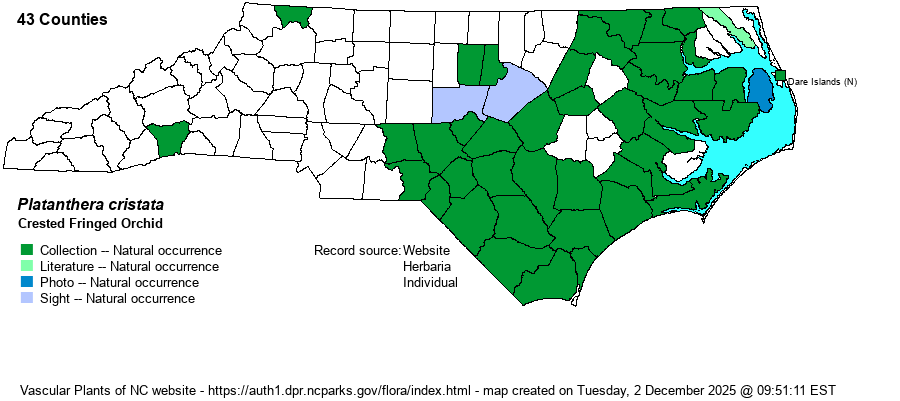| Author | (Michaux) Lindley | |
| Distribution | Present throughout the Coastal Plain, though nearly absent from the northeastern corner. Ranges westward into the eastern edge of the Piedmont, west to Chatham and Montgomery counties. A few scattered, disjunct records from the Mountains; however, a specimen from Haywood County is not available on SERNEC for corroboration and is thus not mapped.
This Southern species does range as far north to MA, but only in Atlantic Coast states. It occurs south to central FL and eastern TX. It does occur as a disjunct inland in the Cumberland Mountains/Plateau in KY and TN. | |
| Abundance | Uncommon to locally fairly common (in well-managed preserves) in the Sandhills and the southern half of the Coastal Plain to the east. Rare to locally uncommon in the northern half of the Coastal Plain, but rare in the eastern edge of the Piedmont. Very rare at a few sites in the Mountains. | |
| Habitat | As with most other Coastal Plain Platanthera species, it grows mainly in frequently-burned savannas and wet flatwoods, but it can and does occur in some other grassy places, even grassy roadsides and powerline clearings. It occurs in bogs in the Mountains and streamhead ecotones and seeps in the Sandhills. | |
| Phenology | Blooms from late June into September, and fruits shortly after flowering. | |
| Identification | This is a smaller species -- in height and flower size -- than the similar P. ciliaris, which also has orange flowers. It grows to about 1-1.5 feet tall, with a few narrow leaves on the lower part of the stem. The flower cluster is much smaller and more dense than that taller species, with the inflorescence only being about 2-3 inches high but with several dozen densely-packed flowers, each about 1/3-inch across. Flowers vary from golden-orange to medium orange, and are definitely more orange in color than the similar-in-stature P. integra, which is more yellow in flower color. The lips are strongly fringed, but as the flower cluster is so dense, you likely will not notice the spurs on the flowers. It often grows with P. ciliaris, P. integra, and the white-flowered P. conspicua; if you are lucky, you could see all four in bloom at the same time in late summer. | |
| Taxonomic Comments | None, other than it being named as Habenaria cristata a few decades ago.
| |
| Other Common Name(s) | Golden Fringed Orchid, Crested Orange Bog Orchid, Crested Yellow Orchid, Yellow Crested Orchid. No name is universally used, and the odds of two references using the same common name is not high! | |
| State Rank | S4 | |
| Global Rank | G5 | |
| State Status | | |
| US Status | | |
| USACE-agcp | OBL link |
| USACE-emp | FACW link |

